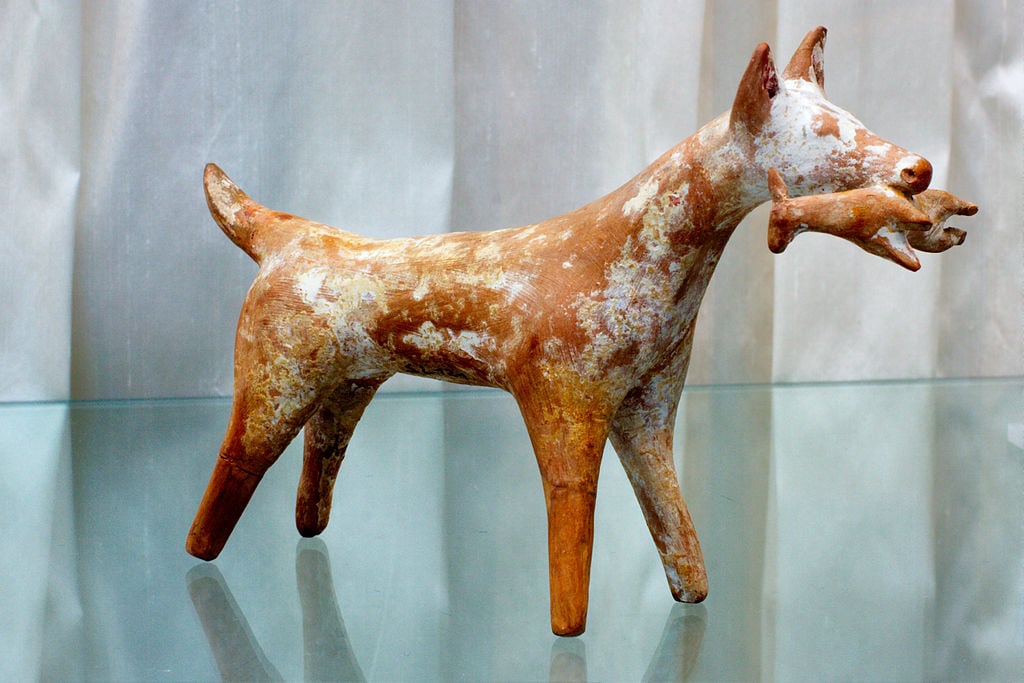Alopekis, the Ancient Greek Dog Breed - GreekReporter.com (original) (raw)

Ancient Greeks loved their pets. An Archaic Greek statue of a dog and her puppy. Credit: User:MatthiasKabe /Wikimedia Commons/CC BY-SA 3.0.
The Alopekis is a small, fox-like dog breed with a rich history rooted in ancient Greek culture and rural life. Although not widely known outside of its place of origin, this breed has been around for millennia. It has served as a versatile companion to Greek farmers and families. This ancient canine symbolizes a living link to the past, embodying a collaboration that transcends species.
Origins and etymology
The name “Alopekis” comes from the Greek word “alopex” (Greek: αλώπηξ), meaning “fox.” The name aptly describes the breed’s appearance, which features a pointed muzzle, sharp ears, and a bushy tail. These traits give it a distinctly fox-like look. The breed’s origins are ancient. While precise documentation is scarce, historians believe the Alopekis appeared in rural Greece thousands of years ago. It quickly became an integral part of the community.
The Alopekis in Art and Literature
Greek art and literature provide evidence of the ancient Greek dog breed’s long history. Small, fox-like dogs frequently appear in ancient Greek pottery, sculptures, and mosaics, suggesting that Greeks valued these dogs. For example, a hunting scene resembling the Alopekis is depicted on a 6th-century BC Corinthian black-figure krater. In this artwork, it appears alongside hunters, likely symbolizing its role as a hunting or companion dog.
Though often generalized, literary references also indicate the presence of small, versatile dogs in Greek households and farms. The ancient Greek historian and philosopher Xenophon mentions small dogs in his treatise “Cynegeticus” (“On Hunting”). Although Xenophon primarily focuses on larger hunting dogs, his acknowledgment of smaller breeds suggests their prevalence in Greek society.
According to ancient authors, such as Xenophon, Alopekis were believed to result from breeding between dogs and foxes. Leaving genetic possibilities aside, this ancient belief that foxes and dogs procreated to breed the Alopekis is a testament to just how fox-like the canine seemed even in antiquity. The species’ fox-like instincts, combined with its agility and sharp senses, likely suited it to tasks like hunting small game and guarding livestock.
The role of the beloved canine in society

A Greek black-figured column krater illustrates a scene of naked men with spears and dogs hunting a wild boar. This “Hunt krater” was crafted in Corinth around 570 BC Credit: Graikopithikos, via Wikimedia Commons. Public Domain
The Alopekis played multiple roles in ancient Greece and was deeply integrated into rural life. Its small size, intelligence, and versatility made it an ideal farm dog, and it performed essential tasks in agrarian societies. One primary role of the Alopekis was controlling vermin. Its agility and keen senses allowed it to hunt and eliminate rodents and other pests which threatened food stores and crops. This role proved crucial in maintaining farm productivity and health.
The Alopekis also effectively guarded small livestock, such as chickens, rabbits, and even young lambs. Its alertness and natural suspicion of strangers made it a reliable watchdog, often alerting farmers to predators or intruders. In addition to these roles, the ancient breed served as a valued companion animal. Its affectionate nature and loyalty endeared it to many Greek households. The canine’s close bond with humans is evident in its continued presence in Greek homes throughout the centuries.
Cultural significance and preservation of the ancient breed
The ancient alopekis is unique in Greek cultural heritage. As a breed that has survived largely unchanged for thousands of years, it represents a living link to the past. It embodies qualities such as intelligence, loyalty, and utility, which ancient Greek society valued. The recurring depictions of small, fox-like dogs in Greek art underscore the Alopekis’ importance in ancient culture. These artistic representations highlight not only the breed’s aesthetic appeal but also its functional roles.
Although direct references to the Alopekis by name are rare in ancient texts, the breed’s characteristics align with descriptions of small, versatile dogs in Greek literature. The consistent portrayal of these dogs in art and literature across different periods underscores their enduring presence in Greek society.
Conservation efforts
Today, the Alopekis remains rare and is primarily found in rural areas of Greece. Major international kennel clubs do not recognize the breed despite its long history, contributing to its obscurity outside Greece. However, in its homeland, people cherish the Alopekis for its historical significance and continued role as a farm dog and companion.
In recent years, efforts to preserve the Alopekis have intensified. Greek breeders and dog enthusiasts have taken steps to document the breed’s characteristics, promote its history, and maintain its genetic diversity. These efforts are crucial in preventing the breed from fading into obscurity, as rural life in Greece also becomes modernized.
Increasingly, people recognize the Alopekis as a symbol of Greek heritage, especially in the context of traditional rural practices that are being rediscovered and celebrated. The breed’s resilience and adaptability make it a fitting emblem of Greece’s enduring connection to its past.
Alopekis, the ancient Greek dog breed
The fox-like canine is a testament to ancient Greece’s rich history and culture. Its appearance, versatility, and loyalty have allowed it to endure for thousands of years. The breed has faithfully served Greek farmers and families across generations. As efforts to preserve and celebrate the breed continue, the Alopekis symbolizes Greece’s animal solidarity. It is a reminder of the deep connections between humans and their canine companions throughout history.